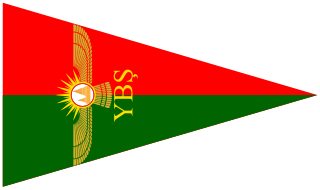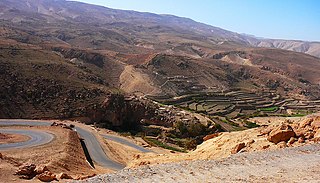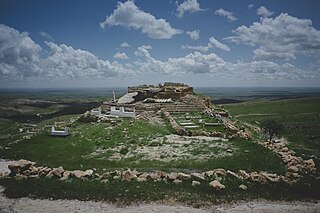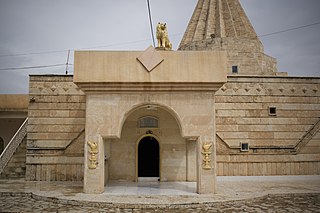
Sinjar is a town in the Sinjar District of the Nineveh Governorate in northern Iraq. It is located about five kilometers south of the Sinjar Mountains. Its population in 2013 was estimated at 88,023, and is predominantly Yazidi.

Lalish is a mountain valley and temple in Shekhan, Duhok Governorate in Iraq. It is the holiest temple of the Yazidis. It is the location of the tomb of the Sheikh Adi ibn Musafir, a central figure of the Yazidi faith.

Yazidis or Yezidis are a Kurdish-speaking endogamous ethnoreligious group who are indigenous to Kurdistan, a geographical region in Western Asia that includes parts of Iraq, Syria, Turkey and Iran. The majority of Yazidis remaining in the Middle East today live in Iraq, primarily in the governorates of Nineveh and Duhok.

Bashiqa is a town situated at the heart of the Nineveh plain, between Mosul and Sheikhan, on the edges of Mount Maqlub.

The Sinjar Resistance Units is a Yazidi militia formed in Iraq in 2007 to protect Yazidis in Iraq in the wake of attacks by Sunni Islamist insurgents. It is the second largest Yazidi militia, after the Êzîdxan Protection Force (HPÊ). However, it is much more active than the HPÊ in fighting against the Islamic State of Iraq and the Levant (ISIL).

The Sinjar District or the Shingal District is a district of the Nineveh Governorate. The district seat is the town of Sinjar. The district has two subdistricts, al-Shemal and al-Qayrawan. The district is one of two major population centers for Yazidis, the other being Shekhan District.

The Sinjar massacre marked the beginning of the genocide of Yazidis by ISIL, the killing and abduction of thousands of Yazidi men, women and children. It took place in August 2014 in Sinjar city and Sinjar District in Iraq's Nineveh Governorate and was perpetrated by the Islamic State of Iraq and the Levant (ISIL). The massacre began with ISIL attacking and capturing Sinjar and neighboring towns on 3 August, during its Northern Iraq offensive.
Human rights in the territory controlled by the Islamic State (ISIL/ISIS) are considered to be in one of the worst states, if not the worst state in modern history and it has been harshly criticized by many political and religious organisations, as well as by many individuals. The Islamic State's policies included acts of genocide, torture and slavery. The United Nations Commission on Human Rights (UNCHR) has stated that the Islamic State "seeks to subjugate civilians under its control and dominate every aspect of their lives through terror, indoctrination, and the provision of services to those who obey". Many Islamic State actions of extreme criminality, terror, recruitment and other activities has been documented in the Middle East.

Yazidis in Syria refer to people born in or residing in Syria who adhere to Yazidism, a strictly endogamous religion. Yazidis speak the Kurdish language of Kurmanji. Although some are scattered in Turkey and the Armenia, Iraq is the center of their religious life, the home of their Amir, and of the tomb of their most revered saint, Sheikh Adi. Yazidis in Syria live primarily in two communities, one in the Al-Jazira area and the other in the Kurd-Dagh.

The Êzîdxan Women's Units is a Yazidi all-women militia formed in Iraq in 2015 to protect the Yazidi community in the wake of attacks by the Islamic State of Iraq and the Levant and other Islamist groups that view Yazidis as pagan infidels.

A genocide of Yazidis by the Islamic State was carried out in the Sinjar area of northern Iraq in the mid-2010s. The genocide led to the expulsion, flight and effective exile of the Yazidis. Thousands of Yazidi women and girls were forced into sexual slavery by ISIL, and thousands of Yazidi men were killed. About 5,000 Yazidi civilians were killed during what has been called a "forced conversion campaign" carried out by ISIL in Northern Iraq. The genocide began after the withdrawal of Iraqi forces and Peshmerga, which left the Yazidis defenseless.
Kocho is a village in Sinjar District, south of the Sinjar Mountains in the Nineveh Governorate of Iraq. It is considered one of the disputed territories of Northern Iraq and is populated by Yazidis. The village came to international attention in 2014 due to the genocide of Yazidis committed by the Islamic State.
Mahad is a village located in the Shekhan District of the Dohuk Governorate of Kurdistan Region in Iraq. The village is located 9 kilometres (5.6 mi) southeast of Ain Sifni in the Nineveh Plains. Mahad is populated by Yazidis.

The persecution of Yazidis has been ongoing since at least 637 CE. Yazidis are an endogamous and mostly Kurmanji-speaking minority, indigenous to Kurdistan. The Yazidi religion is regarded as "devil-worship" by Muslims and Islamists. Yazidis have been persecuted by the surrounding Muslims since the medieval ages, most notably by Safavids, Ottomans, neighbouring Muslim Arab and Kurdish tribes and principalities. After the 2014 Sinjar massacre of thousands of Yazidis by ISIL, which started the ethnic, cultural, and religious genocide of the Yazidis in Iraq, Yazidis still face discrimination from the Iraqi government and the Kurdistan Regional Government.

Quba Mêrê Dîwanê is the world's largest Yazidi temple. It is located in the Armenian village of Aknalich, in the province of Armavir, where the Yezidis are the largest minority. The village of Aknalich is located 35 kilometers west of Yerevan, the capital of Armenia.

Sultan Ezid Temple is a Yazidi temple located in Tbilisi, the capital of Georgia.

Mam Rashan Shrine is a Yazidi site built in the 12th century located on Mount Sinjar in Iraq. The shrine is dedicated to Mam Rashan, a Yazidi saint associated with agriculture, rain, and the annual harvest.

Pir Mam Rashan or Pir Mehmed Reshan was a 12th-century Yazidi saint. The Mam Rashan Shrine on Mount Sinjar was built in honor of him.
Alphabetical index of articles about the Yazidis, and their history and culture.







































